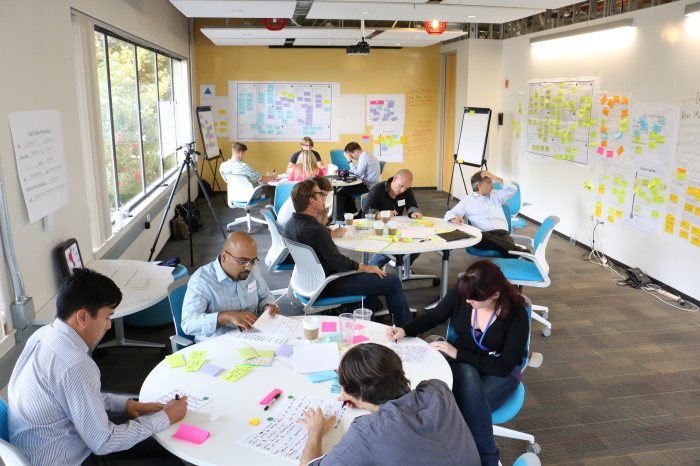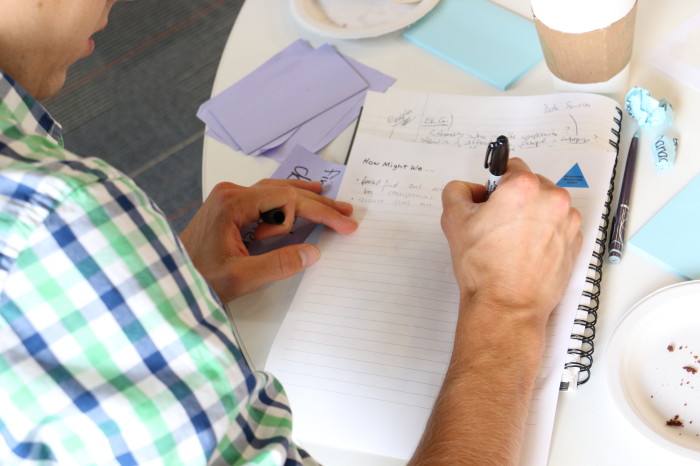
- SAP Community
- Groups
- Interest Groups
- Application Development
- Blog Posts
- The 2014 M-Prize Workshop: A Unique Innovation Ex...
- Subscribe to RSS Feed
- Mark as New
- Mark as Read
- Bookmark
- Subscribe
- Printer Friendly Page
- Report Inappropriate Content
When you think of a Design Thinking workshop, you probably envision a group of people working together to solve one particular problem. However, last week, the Design & Co-Innovation Center from SAP took a whole new approach by bringing together three organizations with vastly different goals to collaborate and learn from each other. I had the unique opportunity of seeing innovation at its core during the M-Prize Design Thinking workshop. It was truly eye-opening and inspiring to see how this methodology could be applied to a variety of ideas to produce such effective results in a short span of time.
What is the M-Prize?
To provide a little bit of background, the 2014 M-Prize "Unlimited Human Potential" challenge is an annual global contest for entrepreneurs, hosted by the Management Innovation Exchange (MIX) organization. The contest allows for participants around the world to present their innovative ideas around unlocking human potential and improving people’s work lives to a panel, who then select the top 7 finalists. These finalists have the opportunity to attend a Design Thinking workshop conducted by SAP Labs along with other events that allow them to further their ideas. This specific M-Prize workshop was particularly interesting as it had three different organizations at different maturity levels attending and applying the same methodology to their projects. While it proved challenging at times, it brought out many different perspectives and allowed for a variety of participants to provide their input on each organization’s business model.
The Innovators & Their Ideas
The workshop itself was held over the course of two days and was filled with an array of different activities to guide the participants in opening their minds to the user needs and understanding their target audiences. The participants were
- Nomatik – A relatively mature company whose aim is to provide global coworking spaces for various professional talents to collaborate and connect for their mutual benefit.
- Enspiral – An alpha phase collaborative budgeting application
- EKG (Enterprise Knowledge Graph) – An early stage proof of concept for a platform that allows enterprise organizations to reinvent their knowledge management by gathering and connecting information found in the disperse information/knowledge management systems present in large corporations.
Each group had two representatives who worked alongside three SAP business professionals to clarify, articulate, and enhance their business plans.
Day 1
Design Challenges & Delving Deeper
Following a series of icebreakers, introductions, and brief talks from the SAP Business Professionals, each team was given individual design challenges relating to their project’s goals. These design challenges were crafted after interacting with each of the teams to understand the current state of their ideas, their challenges, and future aspirations. The groups refined their respective design challenges to identify the right focus for the workshop and came up with the following:
- Enspiral Design Challenge: “How might we position cobudget to be adopted in the right contexts for maximum impact?”
- Nomatik Design Challenge: “How might we expand nomatik coworking to a wider audience profitably?”
- EKG Design Challenge: “How might we define the right focus for EKG for faster adoption?”
Each group then came up with a one-line pitch that clearly articulated their position. The activities on the first day centered on delving deeper into the ideas the teams had come in with and enhancing those ideas to clearly define who the key stakeholders were and what the most effective business plan was. Using a Business Model Canvas, each team identified their key partners, key activities, key resources, value propositions, customer relationships, channels, customer segments, cost structure, and revenue stream. Each team also selected three key stakeholders and defined their personas. The groups then presented this information to others. This activity paved the way for a very interactive discussion between all the teams to identify the strong and weak points in their plans and provide different perspectives from outsiders. The first day of the workshop came to a close with each individual coming up with 10 “How might we…” questions that addressed their challenges and concerns.
Day 2
The Good & The Bad
The second day of the M-Prize workshop seamlessly weaved together the previous day’s activities to yield new insights, potential solutions for foreseeable challenges, and concrete future goals. All participants wrote post-it notes full of ideas for each company addressing where and why they thought the company could succeed or fail. Hearing so many different perceptions of the same company allowed for each team to flesh out any assumptions they were making and forcibly face the flaws with their plans.
Problem Solving
To wrap up the workshop, everyone had the initially daunting task of coming up with answers to the challenges their organizations faced. Participants were split into two groups and each member was given one of the “How might we…” questions from the previous day. Everyone individually came up with ideas to solve the problems and rotated questions periodically until there were 15 ideas written per question. This process of ideation ensured that each participant not only generated ideas themselves, but they also built on top of one another’s ideas. Organizations regrouped to see the proposed solutions to their problems and identify which ideas they found most helpful and how to proceed with their new ideas. This activity was arguably one of my favorites, as I watched individuals tackle these challenges and come together to come up with innovative solutions to really aid in the development of these companies.
Overall, the workshop elicited an overwhelmingly positive response from the participants and resulted in each company leaving with a list of action items and a new angle to view their product from. Everyone left the workshop recharged and ready to innovate with a fresh perspective!
Mashhood Alam lead the design team comprising Tim Thianthai, Henning Kollenbroich and Kevin Langer from SAP Design and Co-innovation Center facilitated the workshop.
- SAP Managed Tags:
- Design Thinking
You must be a registered user to add a comment. If you've already registered, sign in. Otherwise, register and sign in.
-
A Dynamic Memory Allocation Tool
1 -
ABAP
8 -
abap cds
1 -
ABAP CDS Views
14 -
ABAP class
1 -
ABAP Cloud
1 -
ABAP Development
4 -
ABAP in Eclipse
1 -
ABAP Keyword Documentation
2 -
ABAP OOABAP
2 -
ABAP Programming
1 -
abap technical
1 -
ABAP test cockpit
7 -
ABAP test cokpit
1 -
ADT
1 -
Advanced Event Mesh
1 -
AEM
1 -
AI
1 -
API and Integration
1 -
APIs
8 -
APIs ABAP
1 -
App Dev and Integration
1 -
Application Development
2 -
application job
1 -
archivelinks
1 -
Automation
4 -
BTP
1 -
CAP
1 -
CAPM
1 -
Career Development
3 -
CL_GUI_FRONTEND_SERVICES
1 -
CL_SALV_TABLE
1 -
Cloud Extensibility
8 -
Cloud Native
7 -
Cloud Platform Integration
1 -
CloudEvents
2 -
CMIS
1 -
Connection
1 -
container
1 -
Debugging
2 -
Developer extensibility
1 -
Developing at Scale
4 -
DMS
1 -
dynamic logpoints
1 -
Eclipse ADT ABAP Development Tools
1 -
EDA
1 -
Event Mesh
1 -
Expert
1 -
Field Symbols in ABAP
1 -
Fiori
1 -
Fiori App Extension
1 -
Forms & Templates
1 -
IBM watsonx
1 -
Integration & Connectivity
10 -
JavaScripts used by Adobe Forms
1 -
joule
1 -
NodeJS
1 -
ODATA
3 -
OOABAP
3 -
Outbound queue
1 -
Product Updates
1 -
Programming Models
13 -
Restful webservices Using POST MAN
1 -
RFC
1 -
RFFOEDI1
1 -
SAP BAS
1 -
SAP BTP
1 -
SAP Build
1 -
SAP Build apps
1 -
SAP Build CodeJam
1 -
SAP CodeTalk
1 -
SAP Odata
1 -
SAP UI5
1 -
SAP UI5 Custom Library
1 -
SAPEnhancements
1 -
SapMachine
1 -
security
3 -
text editor
1 -
Tools
17 -
User Experience
5
| User | Count |
|---|---|
| 4 | |
| 2 | |
| 2 | |
| 2 | |
| 2 | |
| 1 | |
| 1 | |
| 1 | |
| 1 | |
| 1 |

